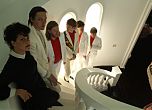
A concrete wave, a postcard pin-up, a modern residential ideal: there are as many ways to describe the COPAN building (‘Edifício COPAN’) as there are angles from which to gaze on its sinuous façade, encased in a shell of sun-shading, slatted brise-soleil.
The immense downtown building, commissioned by the Companhia Pan-Americana de Hotéis, was always intended as a multi-functional space. The original idea was to combine tourism, hospitality and residential spaces in a similar mould to that of New York’s Rockefeller Center.
The blueprint for the project started coming together in 1951, on the drawing board of the late, great architect Oscar Niemeyer, with plans for 72 shops, a cinema, and 1,160 apartments, ranging from around 26m2 to 250m2, split between six blocks and 32 floors. All this encased in a magnificent ‘S’ shape, whose curves were symbolic of Niemeyer’s modern approach.
The project was finally finished in 1966, minus the hotel and the hanging gardens originally envisaged by Niemeyer, but a city within a city nonetheless, complete with stores, salons, laundrettes, bars and restaurants.
The COPAN remains the largest apartment complex in Latin America, home to a wonderfully eclectic set of 5,000 or so residents, and though the inner sanctum of the COPAN – that is, its more than 1,000 apartments – is off limits to all but residents and their friends, there are a number of ways that visitors can appreciate this city treasure from within, be it with a bite to eat, a nose round the shops, or an espresso at one of the city’s oldest cafés.
The Edifício COPAN is at Avenida Ipiranga 200, República (3259 5917/ copansp.com.br)
Bar da Dona Onça
Unit 27 and 29 (3257 2016/ bardadonaonca.com.br)
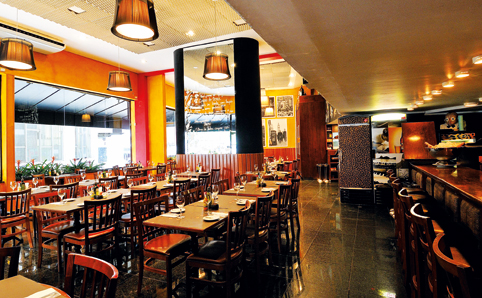 Opened in 2008, Bar da Dona Onça is far and away the trendiest watering hole in the COPAN. Owned by the chef Janaína Rueda, who has won legions of fans with her contemporary twist on rural Brazilian cuisine, the bar-cum-restaurant follows the design aesthetic of the building, with plenty of wood panelling, interspersed with black and yellow walls and colourfully chalked-up blackboards, not to mention leopard print details at every turn.
Opened in 2008, Bar da Dona Onça is far and away the trendiest watering hole in the COPAN. Owned by the chef Janaína Rueda, who has won legions of fans with her contemporary twist on rural Brazilian cuisine, the bar-cum-restaurant follows the design aesthetic of the building, with plenty of wood panelling, interspersed with black and yellow walls and colourfully chalked-up blackboards, not to mention leopard print details at every turn.
The real charm, however, lies in the huge windows that look out onto the neat little street running along one side of the building, where you’ll also find a scattering of outside tables. A plate of rice and beans isn’t cheap – prepare to spend around R$36 on the daily special, with options that include fried fish, chicken, minced meat or omelette, all served with rice, beans and shredded kale. To drink, the bloody mary (R$28) and Caju Amigo (vodka or cachaça with a homemade cashew compote, R$18) are both excellent choices. Read more on Bar da Dona Onça
Temaki Café
Unit 78 (3129 9807/ cafetemaki.com.br)
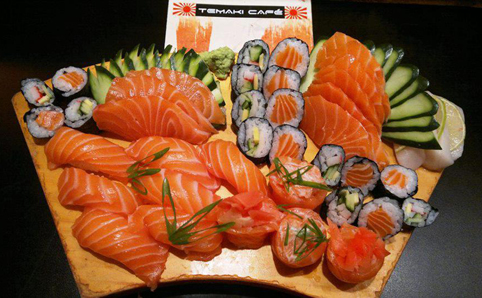 For something a little cheaper, head to one of the informal eateries deep inside the building, on the ground floor. One such place, Temaki Café does a good line in temaki hand rolls and sushi combos – some named after the building’s blocks. The ‘Bloco B’, for example, comes with 6 sushis, 8 makis and 10 slices of sashimi for R$38.90, and you don’t need to live in Bloco B to tuck in.
For something a little cheaper, head to one of the informal eateries deep inside the building, on the ground floor. One such place, Temaki Café does a good line in temaki hand rolls and sushi combos – some named after the building’s blocks. The ‘Bloco B’, for example, comes with 6 sushis, 8 makis and 10 slices of sashimi for R$38.90, and you don’t need to live in Bloco B to tuck in.
The more adventurous should try the house speciality: an ever-changing Japanese tasting menu (R$79), prepared by the chef Toninho-San who hails from Ceará in Brazil’s North-East. A permanent promo of three-for-two on temaki keeps the small two-storey restaurant packed out mid-week at lunchtime. Evenings tend to be more chilled, with jazz playing in the background, though it shuts up early by São Paulo standards, at 10pm (and is lunch-only on Saturdays).
Pizzaria COPAN
Unit 12 (3237 2561/ pizzariacopan.com.br)
This pizza spot is a popular choice among residents, and a good option for solo diners, too, with a meal deal of an individual pizza and a fresh juice or fizzy drink for R$18.90. Photos hung on the restaurant walls show a striking bird’s eye view of the building, as well as back in time, to the era of its construction.
Café Floresta
Unit 21 (3259 8416)
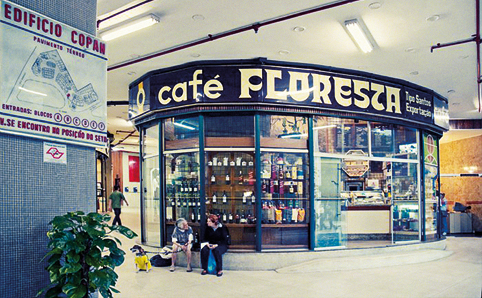 Wherever you dine, top off your meal with a caffeine fix at the COPAN institution, Café Floresta. The standing-room-only café has been running for 38 years and is little more than a counter, open on two sides, with an air of old-world nostalgia. With a discreet ‘bom dia/boa tarde’, join the COPAN residents lined up at the counter, and order an espresso (R$3).
Wherever you dine, top off your meal with a caffeine fix at the COPAN institution, Café Floresta. The standing-room-only café has been running for 38 years and is little more than a counter, open on two sides, with an air of old-world nostalgia. With a discreet ‘bom dia/boa tarde’, join the COPAN residents lined up at the counter, and order an espresso (R$3).
If you’ve still got room, the cakes and tarts made by the wife of one of the Portuguese owners, Adelino Pereira dos Santos, are well worth a try (R$6.50), as is the traditional egg-yolk-and-coconut sweet, quindim (R3.50). Read more on Café Floresta
Pivô
Unit 58 (3255 8703/ facebook.com/pivoarte)
 Moving on to more cerebral pleasures, the recent opening of a new gallery space, Pivô, just a few doors down from Bar da Dona Onça, was an exciting chance for the building’s residents and visitors alike to explore the immense, three-storey space that had lain empty for 20 years. Pivô’s founder, the young artist Fernanda Brenner, invited some of the city’s hottest art talent and gallerists to transform the space for its inaugural exhibition in September 2012.
Moving on to more cerebral pleasures, the recent opening of a new gallery space, Pivô, just a few doors down from Bar da Dona Onça, was an exciting chance for the building’s residents and visitors alike to explore the immense, three-storey space that had lain empty for 20 years. Pivô’s founder, the young artist Fernanda Brenner, invited some of the city’s hottest art talent and gallerists to transform the space for its inaugural exhibition in September 2012.
Strolling through Pivô’s spaces felt something akin to infiltrating the building’s bowels, with previously unexplored roof cavities, curved rooms, galleried halls and spacious verandahs laid bare. Following building works to improve accessibility, the gallery, which also runs an artists’ residency programme, reopens for 2013 with exhibitions by the artists Feco Hamburger and Letícia Ramos in March and April 2013, and a yet-to-be-defined show by the SP gallery Mendes Wood, part of Pivô’s strategy to work hand-in-hand with other cultural spaces. Read more on Pivô
Walério Araújo
Unit 69 (3258 7665)
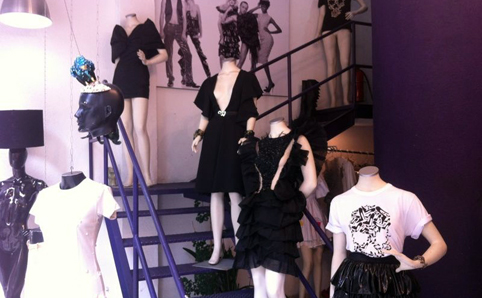 Jumping from art to fashion, those in search of glitzy additions to their wardrobe should swing by the shop belonging to Walério Araújo, the designer and COPAN resident who counts among his regulars the veteran actress and celebrity Elke Maravilha, and the singer Preta Gil. Araújo’s designs are all about flamboyant details such as sequins, frills and plunging necklines. T-shirts start at R$120.
Jumping from art to fashion, those in search of glitzy additions to their wardrobe should swing by the shop belonging to Walério Araújo, the designer and COPAN resident who counts among his regulars the veteran actress and celebrity Elke Maravilha, and the singer Preta Gil. Araújo’s designs are all about flamboyant details such as sequins, frills and plunging necklines. T-shirts start at R$120.
Prices were correct as of February 2013



